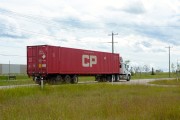Operators of medium- and heavy-duty vehicle (MHDV) fleets frequently cite cost as one of the single biggest impediments to purchasing battery-electric trucks to replace gas- or diesel-powered ones. But the sticker price of a fossil-fuelled vehicle doesn’t reflect its true cost. We urge the Government of Canada to consider the embedded costs to our healthcare system, our environment and the wellbeing of Canadians and to implement policies that will accelerate the transition to low-carbon road freight.
Diesel-powered MHDVs are a disproportionately large contributor to traffic-related air pollution (TRAP). According to Health Canada, TRAP contributes to 1,200 premature deaths, 210,000 asthma symptom days, and 2.7 million acute respiratory symptom days every year. The four-in-ten Canadians who live within 250 metres of a high-traffic roadway are especially vulnerable. And children — whose lungs and brains are still developing — are at even greater risk. Forty-eight percent of schools are located within 200 metres of areas that experience high traffic volumes, and approximately 2.2 million children in Canada travel on school buses every day, 70 per cent of which are diesel-fueled. A known carcinogen, diesel exhaust contains a mixture of toxic particles that are small enough to be inhaled deep into the lungs. Health risks range from throat and lung irritation, wheezing and coughing, to impaired cardiac function, and lung, breast, and bladder cancer. Exposure to diesel exhaust has been linked to the development and worsening of asthma symptoms, behavioral and neurological problems and even childhood leukemia.
The Government of Canada has already begun a push towards the electrification of MHDVs. Since July 2022, the federal government has offered purchase incentives to encourage uptake. In December of 2022, Transport Canada unveiled Canada’s Action Plan for Clean On-Road Transportation to boost the number of zero-emission MHDVs available for sale. Last August, the government invested $3 million in the Zero-Emission Trucking Program to encourage sector-wide readiness for transitioning to clean transportation.
But it’s time for more action, and the Canadian public agrees.
The other cost of diesel
According to a 2023 poll conducted by Abacus Data for the Canadian Lung Association, 79 per cent of respondents are concerned about the effect of traffic emissions on air quality; 83 per cent support the electrification of school buses. Eighty-two per cent support regulations that require auto makers and importers to sell zero-emission MHDVs as increasing percentage of their total sales until all new truck and bus sold are emission-free models by 2040.
It’s time that we re-frame concerns about the upfront expense of purchasing an MHDV. Instead of posing the issue as a matter of price, it should be framed as a matter of cost. We must consider the costs of conventional road freight over its lifespan as well as the costs of TRAP-related diseases and health issues. And this cost is not insignificant. The Atmospheric Fund has calculated that Canada’s proposed federal zero-emission vehicles regulation will result in over $90 billion in health savings over the next 25 years, including up to 11,000 avoided premature deaths.
This reframing will not happen organically. The federal government must advance the electrification of MHDVs through implementing policies and regulations (including a progressive sales standard) that accelerate the replacement of internal combustion MHDVs with low-carbon ones. Given the host of benefits that accompany a switch to zero-carbon road transport, and the urgency of the climate crisis, there is little time to lose. Stronger regulations to speed up the transition to emission-free vehicles is vital to reducing the negative health impacts of fossil-fueled MHDVs and ensuring a climate-safe future for all Canadians.







